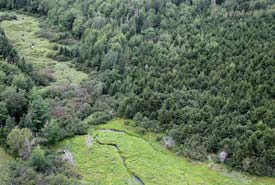Docherty's Brook

Docherty's Brook, NS (Photo by Mike Dembeck)
Cedar is an uncommon species in Nova Scotia, made even rarer by human activity such as logging and harvesting in the 19th and 20th centuries. It has played an important role as a ceremonial plant in Mi’kmaw culture. Its light weight and ease of split make it ideal for building canoes.
Today these trees stand tall in the 167-hectare (412-acre) Docherty’s Brook property near the Pugwash River in Cumberland County, and are protected from intensive industrial forestry. The surrounding region boasts mature Wabanaki (Acadian) forests that support many species of plants and animals.
For years, the property was carefully stewarded by Bonnyman & Byers, a family owned Nova Scotian forest management company. The decision to donate the land was a fit between the company’s goals and those of the Nature Conservancy of Canada (NCC). Both the landowners and NCC envisioned a property where sustainable woodland management could continue while promoting a healthy and diverse habitat for generations to come.
The property may be added to an adjacent protected area, Docherty’s Brook Nature Reserve, which is protected under the Nova Scotia Parks and Protected Area Plan. Docherty’s Brook is also only four kilometres northeast of the 585-hectares (1,444-acre) Wallace Bay National Wildlife Area and five kilometres upstream from NCC’s nature reserve at the Pugwash Estuary.
Ecological significance
The forest is home to populations of two species at risk among a diversity of trees characteristic of Wabanaki (Acadian) forests:
- A stand of over 600 eastern white cedars, a species that is designated as vulnerable under the province’s Endangered Species Act, grows on the property. It is one of the largest stands in the province.
- A small stand of black ash trees, which are listed as threatened under Nova Scotia’s Endangered Species Act.
Other tree species, including sugar maple, red maple, yellow birch and eastern hemlock. White pine and balsam can also be found on the site.
A natural partnership
In addition to the generous land donation by Bonnyman & Byers, the Nature Conservancy of Canada wishes to acknowledge the following financial contributors:
- Environment and Climate Change Canada, under the Natural Areas Conservation Program
- TD Forests
- Nova Scotia Fisherman
- The Nova Scotia Crown Share Land Legacy Trust
Learn more
Read about our other TD Forests conservation projects.




